President's Observations
Since my last message, I participated in quite a few activities related to nature and involving the PFN. There were the trips to Long Point and Rock Point which I would like to repeat next year. There was a Short Hills wildflower walk, and a nature hike through St. John's Conservation Area with cub scouts turned out to be worthwhile for all. I was put to the test during the long weekend in May and searched for as many bird species as I could find for the Baillie Birdathon. There were the annual BOS counts and Jean and I as well as fellow PFN members assisted with John Black's bird migration study. Results for 2014 are in and the link can be found on our website. Speaking of the website, I'm working with Adrian Lawler to update the Gallery. Look for new images to be added soon. I've been updating the PFN Facebook page with interesting material and PFN-related outings.
It was a beautiful day for the annual picnic at the Minchin's property. In early September, I attended the Irish Grove Woodlot Open House to view the threatened Carolinian ecosystem in Grimsby. We had Bruce Mackenzie speak to the PFN about this woodlot at our September meeting and an outing is planned for October 18. When we find out the date for the Public Information Center regarding the Irish property, we'll let PFN members know. Representing the PFN at the Bert Miller Nature Club Butterfly Festival on September 20 was a pleasure for Jean and I. Many thanks to Janet Damude for filling in at the booth so we could observe the release of tagged Monarch butterflies. The annual event was fun for adults and kids alike, and I look forward to participating in it next year. On Saturday October 6, Jean and I attended the
Ontario Nature fall 2014 Regional Meeting hosted by Nature's Calling Environmental Education. A beneficial event to share and exchange information with fellow naturalists.
We have additional outings planned for the fall and I hope to see you on one of them because when you are driving down a road while birding or you're hiking along a nature trail, you never know what you'll find.
by Bob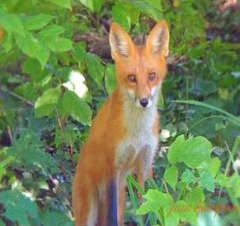
Photo by Jean Hampson
- P.2 -
- Contrails; Speakers Program
- P.3 -
- Welland Cub Scouts walk
- P.4 -
- Irish Grove; Fall Outings
- P.5/6 -
- Bob's Baillie Birdathon
- P.6 -
- PFN Picnic; St. Cath. Xmas Bird Count
- P.7 -
- Pelee Island
- P.8 -
- Photo-page
FALL COLOURS AND CONTRAILS : AS SEEN BY Paul Summerskill
I looked at the sky this past fall (2013) from a remote lake in Algonquin Park to observe endless condensation trails created by jet aircraft. At night, flashing lights of commercial aircraft slowly moved across the sky, then faded in the distance as they also left unseen contrails behind them.
At home, I went to Flighttracker24.com on my computer to see what aircraft may be using the airspace over the park. Through the internet, I discovered that the number of commercial aircraft over Algonquin Park at that moment was only three of the 20,000 to 46,000 commercial flights around the globe in the air at any given time.
There are an average of 28,537 commercial flights over the United States per day, which does not include a total of 59,400 private, military, taxi aircraft and 2,000 cargo airplane flights. The average number of people travelling by air over the United States in any given hour is 61,000. Every day thousands of commercial flights from various parts of the world use Canadian airspace when travelling within, to and from North America. Similar statistics can be found or Europe, China, Japan, the Near and Far East, Africa and South America.
A 747 is a wide-bodied commercial airliner, known as a jumbo jet, that carries 416 passengers and uses one gallon of fuel per second at takeoff. A 747 uses between 20,000 and 30,000 pounds of fuel per hour of flight or 5,000 gallons of fuel per hour. A 747 making an eight hour flight requires 30,000 pounds of fuel for takeoff and cruising, which is 44,600 gallons of aircraft fuel. Air travel is increasing by 5% per year. Cargo transportation by air is increasing by 7% per year. Today the Airbus 380 can carry 853 economy class passengers.
After camping in Algonquin Park, we drove home in our car which, as of August 15, 2011, was only one car of the one billion cars now in the world. Air and ground transportation and all the other uses of crude oil require 3 billion, five hundred and seventy million (3,570,000,000) gallons every day. Americans consume 400 million gallons of gasoline on an average day.
In 2012, for the first time in history, over 60 million passenger cars were produced within a single year. One hundred and sixty-five thousand (165,000) new cars are produced every day, not including light commercial vehicles, heavy trucks, buses and minivans. China and the growing economies of India and Brazil are leading the world in demands for cars. Beijing alone now adds nearly 1,500 cars to its roads every day.
Contrails over Algonquin Park together with other contrails are weaving a global blanket of atmospheric insulation, while motor vehicles produce more air pollution than any other single human activity. Enjoy the fresh air while there is still some around!
Speakers Program 2014
Monday, October 27
John Black /
Marcie Jacklin
Topic: Birding Northern Peru
Monday, November 24
Paul O'Hara
Topic: Marker Trees (Also our Dessert Night)
Reminder: PFN meets on the 4th Monday of each month, not always the last Monday!
An Outing with the 9th Welland Cub Scouts
This spring the PFN was contacted by Scout Leader Jeff Hetherington from the 9th Welland Cub Scouts with a request for a guided hike of a nature area. So on May 10, Bob Highcock, Jean Hampson and Janet Damude met with 8 Cubs and 3 Leaders in the parking lot of St. John's Conservation Area for an afternoon hike. The purpose of the walk was to introduce the Cubs to the sights, sounds and smells of nature.
Janet introduced them to the pungent aroma of Skunk Cabbage as the group started the hike towards the St. John's Ridge Trail - a scent that the President of the PFN had never experienced before either. Trillium and Trout Lily were in flower, and May-Apple was present. In the area of the spring-fed pond we found frogs, small fish, and all the boys had a good view of a garter-snake.
As the group started the climb up the ridge, the songs and calls of a variety of birds could be heard. The Cubs were treated to the persistent song of a Field Sparrow and, looking down the slope at the top of the trail, we discovered a small pocket of warblers. Magnolia, Chestnut-sided, Black-throated Green and Hooded Warblers flitted in and out of view, to the excitement of all. Other birds observed included Tufted Titmouse, Black- capped Chickadee, Northern, Dark-eyed Junco and Blue Jays.
We began the descent down the ridge into the swampy area. At the bottom, everyone was fascinated by the antics of a pair of Gray Catbirds. The sight of a resplendent male oriole impressed Scout Leader Jeff as it was a lifer bird for him.
The group completed the trail with only a few grumbles about time spent away from video games. The trip was concluded by Scout Leader Jeff presenting merit badges to the qualified participants. The PFN received certificates of appreciation for supporting youth. The afternoon was enjoyed by PFN and Scouts alike.
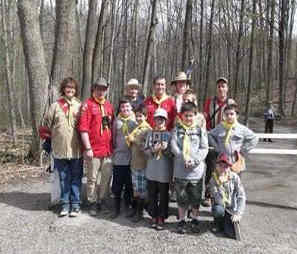
Photo by Jean Hampson - Janet Damude at back middle, Bob at Back right
Irish Grove Woodlot
(presented
by Bruce Mackenzie)
A century-old woodlot in the heart of a Niagara town is, by now, a rather rare sight - and even more rare to have been stewarded by the same family for that century. However, this is the case with the Irish Grove Woodlot in Grimsby, where Mr. Ja Irish continues to maintain the forested property which his grandfather started to work in 1915.
Bruce Mackenzie, a Past-President of the Hamilton Nature Club, discussed the situation which now is facing Mr. Irish and his 25-acre woodlot, at the PFN September 22 meeting. The property, at 38 Hunter Road in Grimsby, is the largest woodlot in Grimsby below the Niagara Escarpment. Currently, the Region of Niagara is carrying out an Environmental Assessment, the point of which is to consider a proposed extension of Regional Road # 512, Livingston Avenue, which would extend the road from Casablanca Avenue to Oakes Road. This extension would cut right through the heart of the Irish Grove woodlot, threatening its continued existence.
Bruce acknowledged that, about 4 decades ago, the town expropriated land to include a road right-of-way and installed a small drainage pipe. No other work had been done by the town. Meanwhile the Irish family have managed the forest, never clearing the woodlot. The tree species include White Pine, Shagbark Hickory, Red Oak, and Burr Oak, some having been estimated as being over 250 years old. The pines in particular stand out because of their height. This woodlot is considered as typical of the area's original Carolinian forest.
Curiously, the Region of Niagara's Official Plan recognizes this woodlot as an Environmental Conservation Area (Significant Woodland), which thus acknowledges it as an important part of the natural landscape of Niagara. Also, Mr. Irish questions why the Region would spend money on a study of the property, and a possible road which appears to be unnecessary, as it would lead into areas outside the Town's Urban Boundary.
In the discussion of the issue, it was stated that the Region of Niagara would be holding a Public Information Center (PIC) some time in the fall, where the public can learn more about what is being proposed and make comments about the Environmental Assessment on the proposed road extension. The Peninsula Field Naturalists Club intends to inform our members when and where the PIC is to take place. Also, a tour of the Irish Grove Woodlot by the PFN will take place on Saturday, October 18 - participants should meet at 9:30 a.m. at the Tim Hortons at Vineland to arrange car-pooling for the trip to 38 Hunter Road, Grimsby.
PFN Fall Outings
November 2 (Sunday):
Mud Lake Conservation Area Outing
9:00 a.m. Standard Time (Time changes this weekend)
Meet at Elm St. Entrance to Conservation Area
Leaders: Bob Highcock, Jean Hampson
(905-688-1260)
November 9 (Sunday):
In Search of the Purple Sandpiper
8:30 a.m. to ?
Leader: John Black (905-684-0143)
Location: East Spit of Welland Canal, Port Weller
Baillie Birdathon Report - by Bob Highcock
This past spring, I decided to participate in Bird Studies Canada's Baillie Birdathon. The next step was to pick a day in May to go birding and tally as many species as possible in a 24-hour period. Sunday May 18 was the day. Stopping at many spots during the May Buffalo Ornithological Society count seemed likely to produce the result I was looking for.
After meeting John Black's group in Niagara-on-the-Lake, we all headed over to the Parmalat Settling Ponds to officially start my Birdathon at 7:25 a.m. Waterfowl observed included Canada Goose, Mallard and Hooded Merganser. Many Spotted Sandpipers were found along the edges of the ponds. While scanning the brush and fields south of the ponds, I ticked Northern Harrier, Rock Pigeon, Willow Flycatcher, Eastern Kingbird, Common Yellowthroat, Yellow Warbler, Savannah Sparrow, Song Sparrow, Red-winged Blackbird, Common Grackle and American Goldfinch. There was one more species here. John Black alerted our group to a song of a bird I had not heard sing before and had not seen in Ontario since 2009. It was an Orchard Oriole! A nice addition! We left the ponds with 16 species ticked. The next planned stop was the Port Weller West Pier.
Ships moving through the Welland Canal have delayed us during previous bird counts but this time it was welcomed. While waiting for a barge to pass through Lock 1, we all had great looks at Barn Swallows and Cliff Swallows flying back and forth over the water near the Seaway weir. I was not sure I would find Cliff Swallow. Since the replacement of the bridge in Chippawa, Jean and I have not found this species while assisting with the BOS Count. These Cliff Swallows were nesting in the windows of the Seaway Building adjacent to the lock.
Once in Port Weller, our group split. Philip Downey joined Jean and I on the west pier while John Black and Paula Clark searched for birds in Malcolmson Eco-Park. Not only was it the BOS Count, it was the scheduled day for Jean and I to count migrants for John Black's Port Weller West Bird Migration Study. Before commencing the PWW Count, Great Egrets were observed perched in the willows near the canal. Walking from the Coast Guard Station to the end of the pier, I added Black-crowned Night Heron, Killdeer, Common Tern, Mourning Dove, Red-bellied Woodpecker, Northern Flicker, Great Crested Flycatcher, Warbling Vireo, Tree Swallow, Black-capped Chickadee, House Wren, Carolina Wren, American Robin, Grey Catbird, Brown Thrasher, American Redstart, Northern Parula, Magnolia Warbler, Bay-breasted Warbler, Blackburnian Warbler, Chestnut-sided Warbler, Yellow-rumped Warbler, Baltimore Oriole and House Finch.
Returning to the Coast Guard Station, species were counted for the May BOS Count. Observations for the Birdathon list included Double-crested Cormorant, Ring-billed Gulls, Herring Gull, Downy Woodpecker, Blue Jay, European Starling, Cedar Waxwing, Northern Cardinal and Brown-headed Cowbird.
With 52 species tallied shortly before 10:00 a.m., it was time for our group to split. Jean and I headed for our assigned area within John Black's section while the rest continued the count on the East Pier. A quick stop on Jones Beach in Port Weller East added House Finch to the day's list and a Red-tailed Hawk was observed while traveling south to a planned stop near the new Outlet Mall. I was looking to tick a Great Horned Owl sitting on a nest in the woods west of Homer Road. The road was open but traffic pylons were placed along the side of the road to prevent parking by people heading to the newly opened Outlet Mall. Our parked car attracted the attention of an NRP Officer. He was inquisitive, pleasant and shared a story of a mounted Great Horned Owl he owned. Unfortunately, through too many leaves, we could not spot the owl we had observed earlier in the year but ticked a Northern Mockingbird perched in the brush behind us. On to Lyon's Creek Road in Niagara Falls.
Another miss! The nesting Osprey observed during the Spring BOS Count in April were not found but Rexinger Road produced Eastern Towhee, Chipping Sparrow and Rose-breasted Grosbeak. In Chippawa, American Crow was observed.
While exploring Dufferin Islands and the area above the Falls, Common Merganser, Red-breasted Merganser and Northern Rough-winged Swallow were spotted. It was now the afternoon and while stopped for lunch on the Chippawa Parkway north of the Welland River, I observed Great Blue Heron, Belted Kingfisher and White- breasted Nuthatch. Staying in Chippawa, we visited the feeders on Peter Street but the seed feeders had no visiting birds. The hummingbird feeder across the street attracted a Ruby-throated Hummingbird though. Species number 66.
We continued our travels through urban Niagara Falls and searched for Chimney Swifts in the downtown area. None were sighted but Turkey Vulture was added to the list. There are a few spots along the Niagara Parkway that we check during the BOS Counts and at the Niagara Parks Botanical Gardens we observed Wild Turkey and Eastern Bluebird. Heading towards Queenston Heights, we were on the northern edge of our count area and there was a species I was hoping to find before stopping at Firemen's Park. The Locust Grove Picnic Area on the Parkway is known for Black Vulture sightings and was have viewed a variety of passerines while there as well. It was outside of our areas but the quick stop added Eastern Phoebe, Swainson's Thrush, Indigo Bunting and an excellent view of my target species - closest view of Black Vulture ever! Hiking through Firemen's Park for an hour added Eastern Wood-Pewee, Least Flycatcher, Red-eyed Vireo, Hermit Thrush, Wood Thrush, and Field Sparrow. A nice collection for the Birdathon. Species observed now stood at 79.
Shortly after 4:00 p.m., we finished our BOS Count with a Purple Martin observation. Jean and I returned home for a dinner break before heading out to a few spots before the sun set for the day. I spotted a Chimney Swift flying overhead while standing in my backyard. Another target species ticked! Refreshed from a hearty dinner, Jean and I headed to west St. Catharines to find some grassland species. In the fields south of the new hospital, we found Horned Lark and Bobolink. The sun was setting fast and there was one more species I was confident in adding to the list. We headed up to Thorold and found the resident Mute Swan sitting on Lake Gibson. A good day overall! I observed a total of 84 species and raised over $350 for bird conservation. I would like to thank all that sponsored me and offer thanks to Jean, John, Philip and Paula for assisting me during the Birdathon. I'll do it again next year so I'd best start planning now if I want to tally 100+ species.
(Note: Photo of Bob's Bailie Birdathon, and PFN Picnic Photos at Minchin's are on Page 8)
PFN 2014 Picnic
Saturday June 7 turned out to be a beautiful day for the annual PFN picnic. Sunny skies welcomed members as they arrived at Don and Sue Minchin's farm near the Niagara Escarpment. A Great-crested Flycatcher was calling from the woods, Purple Martins were busy feeding their young and a swarm of honey bees were set to leave one of the hives that a beekeeper left on the property.
Before igniting the barbecue, Don Minchin led the group on a short hike around the property. Nesting boxes were occupied with Tree Swallows and Black-capped Chickadees but the Eastern Bluebird young had fledged and only a single bird was found near the pond. Don did an excellent job of moving burgers from the grill to the plates and the Peninsula Field Naturalists truly appreciate the Minchins for hosting the picnic. It is this hospitality as well as Don's 10 years as Treasurer of the PFN that had him receive a volunteer recognition award from the City of St. Catharines on April 15 , this year. Congratulations, Don! The recognition is well deserved!
The St. Catharines Christmas Bird Count and
Roundup is scheduled for Sunday, December 14.
Birders - Contact Marcie Jacklin "905-871-2577
Roundup site: North Pelham Youth Center, 1718 Maple Street, Fenwick
To assist at the Roundup, call Mary/John Potter
905-892-2566
Pelee Island? I'll Be Chiggered! (by J.Potter)
In mid-July, Mary and I decided to explore Pelee Island, partly because we had never been there and partly because we hadn’t tent-camped anywhere recently. A brochure from the Nature Conservancy of Canada also stimulated our interest, as it discussed some of the scenic areas of the Island, mentioning alvars and odd trees like Blue Ash and Hackberry. So we went.
Our campground, quite near the east lakeshore, was on the opposite side of the Island from where the ferry from Leamington docked. However, we quickly learned that a) anywhere on the Island was no more than a half- hour’s drive; b) nowhere could you exceed 50 kph; and c) everyone would wave a hand in greeting while driving. It’s that kind of a laid-back and friendly place.
We found a quiet and uncrowded campsite, put up our tent and dining-tent (which we had not done in years) and planned where to explore. A few undeveloped properties owned by the Nature Conservancy, Ontario Nature, and Essex Region Conservation Authority sounded interesting, so we went browsing there. The properties were gorgeous, with Hackberry, Pin Oak, Wild Bergamot, Gray-Headed Coneflower, and even a few surprises like Pitcherplant and Bladdernut; and we found the alvars that were mentioned in some publicity pamphlets. I did my best to spot and avoid the ever-present Poison-Ivy.
In our campsite after our first full day of prowling, I noticed a number of red spots that were extremely itchy on my feet and ankles. At the time, I blamed these on mosquitoes, although they seemed a bit more harsh than the usual skeeterbite. By the next morning, I was scratching many spots and wondering whether poison-ivy had ever before showed up that fast.
On our second day, we visited several nature reserves, finding Hackberry being ubiquitous, and Blue Ash also healthy - although other Ash species were obviously being decimated by Emerald Ash-borer. We visited the old lighthouse at Lighthouse Point, and sampled some excellent wines at the Pelee Island Winery - but all along, that itchy feeling was creeping up my legs. In camp that evening, Mary mentioned having the same symptoms - and she is not sensitive to Poison Ivy!
By the next day, when we departed the Island, the itching was intense, red spots with blisters were breaking out on both of us, and clearly this was something we had never experienced before. When we arrived home, Mary fired up our computer, entered “Biting insects on Pelee Island” and was rewarded with several pages of information about “Chiggers”!
Now, if you have never heard of ‘chiggers’, you are blessed! We learned that a chigger is the larval six-legged stage of a mite, and only the larval stage attacks mammals. These little guys are tiny enough (0.05 millimetres) to go through clothing and too small to be noticed. They attack with piercing mouthparts that penetrate skin, dissolve skin cells with digestive enzymes, and suck up the fluid. After 4 days they drop off the ‘prey’, leaving a red welt with a white hard central area that itches severely. Unlike mosquitoes, they do not suck blood. We found that the itching lasted for several weeks, and at some spots, blisters occurred which eventually broke, releasing a yellow fluid. We discovered that hydrocortisone relieved the itching and helped healing, but even now, months later, we can still see red marks on our skin where the bites had been. We also observed that the chiggers like to feed where clothing fits tightly over the skin, like under the belt, socks, bra straps, in areas around the ankles, back of knees, armpits, and the groin - so those are the areas that are itchy. Nuff said!!
In summary, if you have never been to Pelee Island, go! You will find the residents very friendly and helpful, the wine is good, the natural areas are beautiful, and the museum has a wealth of local history. Just remember to take along some hydrocortisone, shower often, use the same clothing precautions as if you were dealing with the worst tick-species ever seen, and be aware that tall plants can be a jumping-off place for chiggers! No shorts on the trail!!
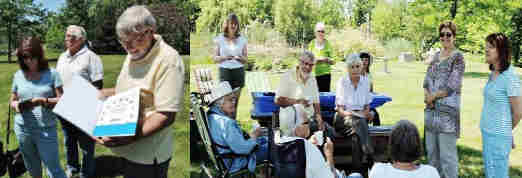
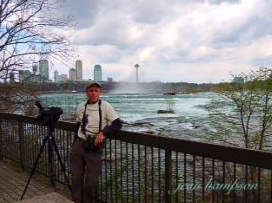
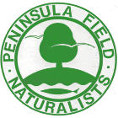
The Peninsula Field Naturalists Club
A non-profit organization started in 1954 with the objectives to preserve
wildlife and protect its habitat, to promote public interest in and a knowledge
of the natural history of the area, and to promote, encourage and cooperate with
organizations and individuals having similar interests and objectives.
Affiliated with Ontario Nature and Nature Canada.
P.O. Box 23031, RPO Carlton, St. Catharines, ON. L2R 7P6
Website : peninsulafieldnats.com
The Peninsula Naturalist
Published: February, April/May, October/November
The Editor welcomes written articles or artwork on any natural history topic.
Please submit typed reports on paper or by email to: jmpotter068@gmail.com
Colour photos (jpg) accompanying articles are welcome. All pieces of artwork
will be accepted. New ideas and constructive criticism are welcome. Please send
submissions by email to e-address above, or by snail-mail to the Club’s postal
address.
Editor: John Potter
Assistant: Mary Potter
–
The Peninsula Naturalist Newsletter,
Published: February, April?; October/November
Download the complete newsletter pdf
